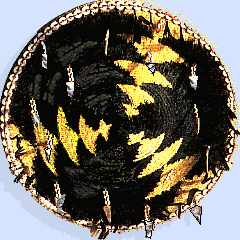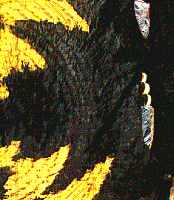"Pomo baskets have the name according to many of being the finest in the world. Evidently basket manufacture is no mere utilitarian routine to them, in which they have settled into mechanical habits like other tribes, but an art, the mastery of which is a stimulus and whose possibilities are played with. The height of this display is reached in the basket whose entire exterior is a mass of feathers perhaps with patterns in 2 or 3 lustrous colors. To the Pomo, these served as gifts and treasures, and above all, they were destroyed in honor of the dead. It is impressive and representative of the gently melancholy sentiments of the Pomo that these specimens of the highest artistic achievement of their civilization were dedicated to the purposes of mourning their kindred." -- A.L. Kroeber (1919) Kroeber is not talking about baskets made for sale to tourists or collectors; he is discussing the general pre-contact state of all the California tribes. His accolade rests not only on the glorious feather and bead baskets, which we'll see here, but also on the great variety of techniques for weaving that the Pomo, alone, practiced. Pomo women were and perhaps still are -- though the purpose now is art, not tools of living -- the finest basket weavers in the world. But Kroeber was an archaologist. He thought about objects and people (all long dead, alas) as objects. Like the wonderful basket above, here, baskets are treated as objects by museums and collectors. No maker's name is bothered with. Baskets are indicators, measurements of a past, of a vanished or vanishing people, rather than artistry of those living and continuing, so why bother with maker names anyway. Indians made it. Where possible in these pages, I name the makers. And tell some stories. For these are not objects, they are alive. |
|
|---|---|
| Thimble miniature gift baskets, like this tiny feathered one by Elsie Allen (1899-1990) are a measure of the weaver's skill. Very finely split willow and sedge demand delicate fingerwork. These miniatures are usually given as gifts that indicate the skill of the weaver. |  |
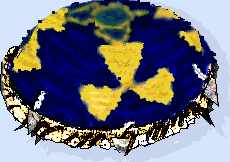 |
Susan Billy, Elsie Allen's grand-niece, made this basket sometime around 1971, after she began to study basket weaving with Elsie. Dark bluish and greenish feathers are mallard, yellow is meadow lark. Quail topknot feathers adorn the clamshell-beaded rim. NOTE: seems too early for Susie, is this perhaps her grandma, Elsie's sister? Elsie ID's it as "Mrs. Susie Billie of Hopland." |
| Suzanne Holder, of the Upper Lake Pomo reservation (Lake County) made this feather basket with a star pattern of mallard and meadow lark feathers sometime before 1972. Abalone triangles dangle from clam-button-bead chains. | 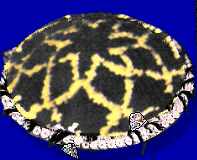 |
| This deeper basket, also made by Suzanne, sometime before 1971, uses orange oriole feathers for an accent on mallard (black) and meadowlark yellow zigzags. | 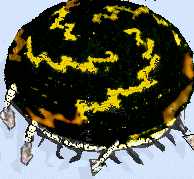 |
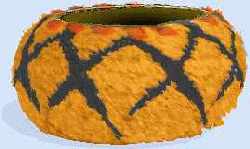 |
Women made all baskets in most tribes -- except the Pomo. Men did rough basketry -- fish traps, willow cradles. William Benson (1862-1930), band chief and historian, is one of the few Pomo men to have learned fine basketry. He made this splendid basket of oriole black and orange feathers and woodpecker red head tufts. Museum of the American Indian. |
| This basket -- Museum of the American Indian, no further info -- is made with blue jay, orange and fluffy black oriole feathers. Feathers are first dried flat, with the skin attached. The quill is then carefully scraped. It's stuck under a sedge coil-stitch at a 45-degree angle. The sedge is then pulled tight to hold it. More feathers are lapped with sucessive stitches. | 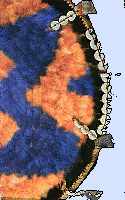 |
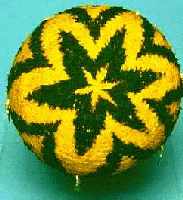 |
A rather deep basket, like Benson's, whose feathers are probably meadowlark and mallard, or black oriole. It's about 8" in diameter. It was made in 1920 (they don't say by whom), and pricey Santa Fe Morning Star Gallery wants $36,000 for it. |
| "Pomo Feather Baskets of the old days were made almost exclusively to be given as gifts to important or very much revered people. So much work went into these baskets that their value today is almost priceless, and any that are for sale start at around $1,000." -- Elsie Allen, Pomo Basketmaking. Well, it's 25 years since she wrote that. Collectibles-inflation's proceded apace. Nevertheless, this does show relative profits to artist-makers and to dealers. | |
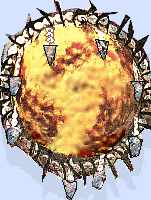 |
This small basket was for sale -- $17,000 from a commercial gallery advertising in 1979. Head feathers of the pileated (red-headed) woodpecker form the red spirals on a background that's probably meadow lark feathers. It shows dealer-artist price differentials at a time close to when (1972) Elsie Allen wrote her book. |
|
She was thinking $1,000 - $2,000; the dealer got 10 times that or more. You see here the value to the Indian artist of an enterprise like the Eastern Cherokee Qualla Mutual Arts and Crafts marketing co-op. Pomo women used to trap birds for special feathered gift baskets for especially respected, loved, or revered people. Now, most birds are protected by law. The women must seek occasional dead birds whose plumage isn't in too bad shape, or make use of non-traditional game bird feathers (pheasant, mallard). Dyed feathers, like chemically dyed basket materials, are felt to be wrong. | |
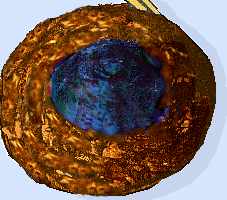 |
Elsie Allen began this partly-finished basket sometime before 1970, using the russet and purple-green neck feathers of a game peasant whose skin she obtained. (Continuation willow rods of the foundation coil protrude from top.) Since these birds are not native to the area, there is no tradition of working with these feathers, no design characteristics. |
| Beaded baskets -- as much or more work to do -- might increase in popularity among the adepts, because wild birds are being killed off by pesticides, aside from being illegal to take. | |
| Elsie Allen' s grandmother -- born sometime in the mid-1800's -- made this basketry compote, probably copied from something she saw at a mission -- in 1916 to show off her skill. She wove black and white seed beads (they were called "Spanish beads" then) into it, imitating patterns traditionally made with dyed bullrush and bleached sedge roots. Pomo beaded baskets are also rare gifts and treasures. | 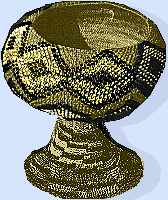 |
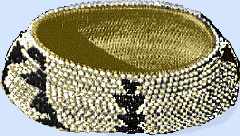 |
Elsie Allen also used beads to imitate an old simple pattern that would have been made with sedge and bullrush root. The white beads emulate the sedge, the black beads the bullrush in this all-over pattern. |
| Annie Lake, of Redwood Valley Pomo Reservation (Mendocino County) made this blue and white beaded all-over triangle flower basket. The beads are put on by running the weft sedge root through the hole for each stitch, no external sewing is done. Beads are woven in as the basket is made. | 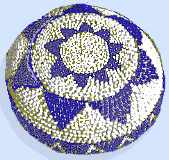 |
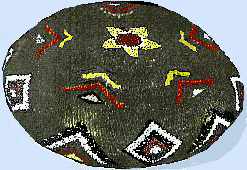 |
Lydia Fort, Lake County Sulphur Bank/Elem Colony Reservation, made this beaded basket sometime before 1972. Its surface is mainly covered with glossy deep black-dyed bullrush root, with a star and diamonds design in beads. To get this black, a dye is made by soaking walnut hulls, ash, and rusty nails in rainwater, aged for 6 months, then the split and dried bullrush roots are put into it for several long soakings and dryings. |
Only black, white, red and yellow beads are used. The combination is an interesting textured glossy surface, with raised bead patterns -- an artistically sophisticated basket whose shiny black seed bead diamonds on a surface of glossy black woven roots forms a subtle touch. "We have a tradition that when we finish a basket, we turn it over and put the knife, the awl, and the last little piece that we cut off on top of it. Traditionally, we let it sit for 4 days so that basket comes to completion. So even though you finish it right then and take the last stitch, it's still not done. "People frequently ask me what these ceremonial baskets hold. They did not have to hold anything, because the basket itself was all that was needed. The basket contained the prayers and the wonderful, good energy that made it a ceremonial basket." -- Susan Billy, Pomo, Elsie Allen's grand-niece and student is now a teacher herself. See a bit more of her essay at NMAI page | |
